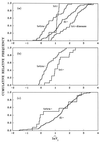Relative mutation rates at di-, tri-, and tetranucleotide microsatellite loci
- PMID: 9023379
- PMCID: PMC19636
- DOI: 10.1073/pnas.94.3.1041
Relative mutation rates at di-, tri-, and tetranucleotide microsatellite loci
Abstract
Using the generalized stepwise mutation model, we propose a method of estimating the relative mutation rates of microsatellite loci, grouped by the repeat motif. Applying ANOVA to the distributions of the allele sizes at microsatellite loci from a set of populations, grouped by repeat motif types, we estimated the effect of population size differences and mutation rate differences among loci. This provides an estimate of motif-type-specific mutation rates up to a multiplicative constant. Applications to four different sets of di-, tri-, and tetranucleotide loci from a number of human populations reveal that, on average, the non-disease-causing microsatellite loci have mutation rates inversely related to their motif sizes. The dinucleotides appear to have mutation rates 1.5-2 times higher than the tetranucleotides, and the non-disease-causing trinucleotides have mutation rates intermediate between the di- and tetranucleotides. In contrast, the disease-causing trinucleotides have mutation rates 3.9-6.9 times larger than the tetranucleotides. Comparison of these estimates with the direct observations of mutation rates at microsatellites indicates that the earlier suggestion of higher mutation rates of tetranucleotides in comparison with the dinucleotides may stem from a nonrandom sampling of tetranucleotide loci in direct mutation assays.
Figures


References
-
- Nei M. Molecular Population Genetics and Evolution. Amsterdam: North–Holland; 1975. - PubMed
Publication types
MeSH terms
Grants and funding
LinkOut - more resources
Full Text Sources
Other Literature Sources

